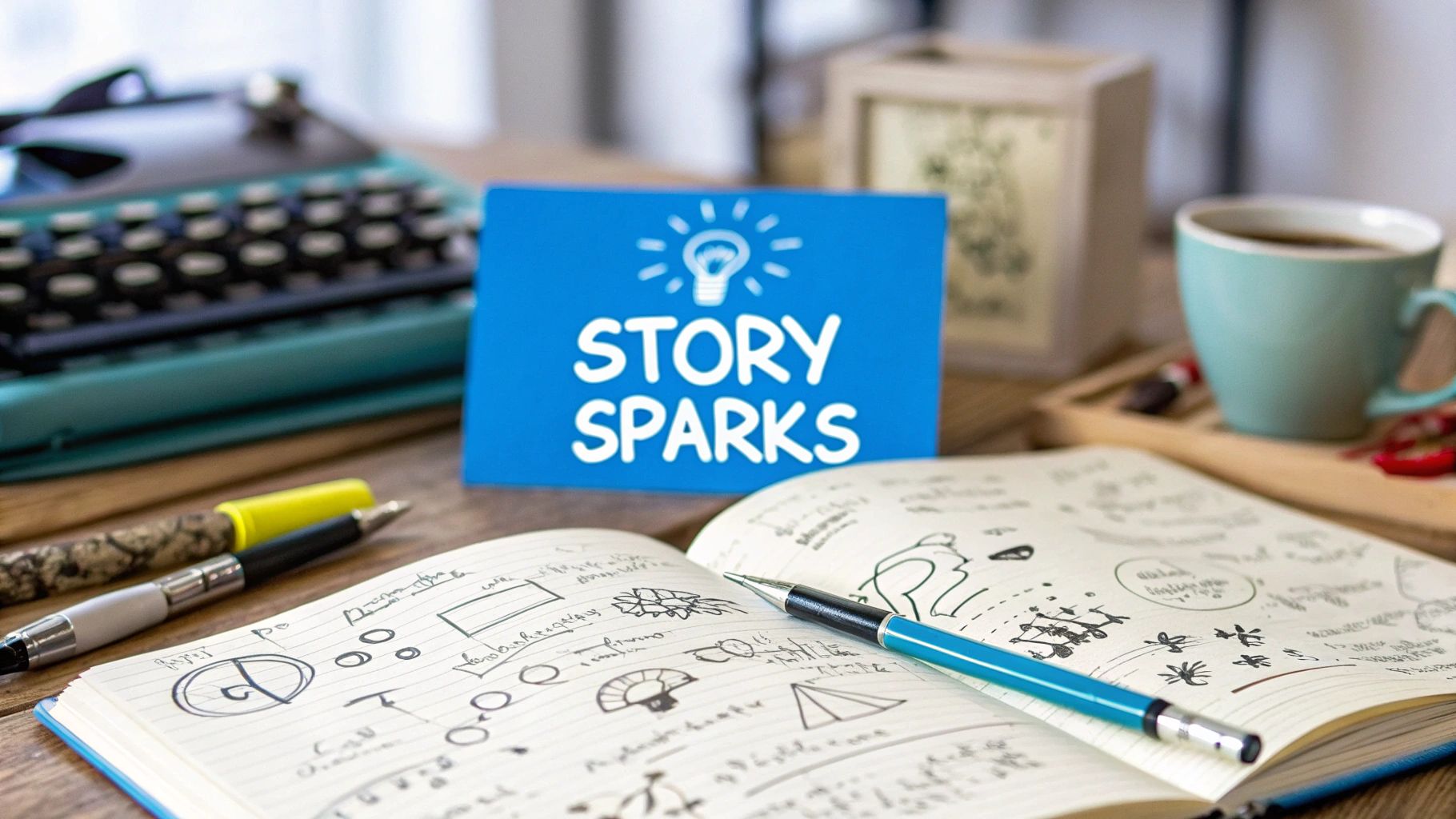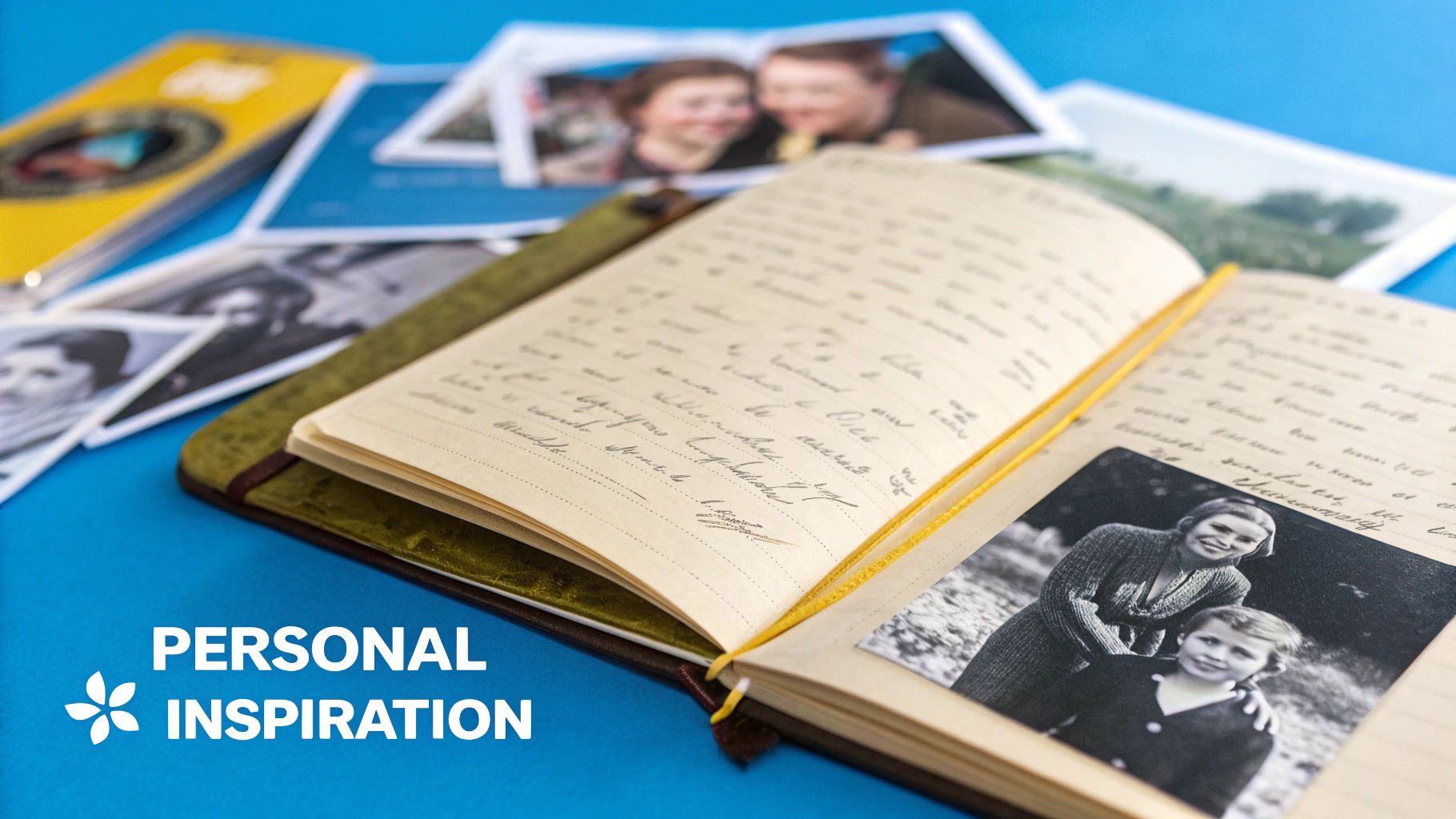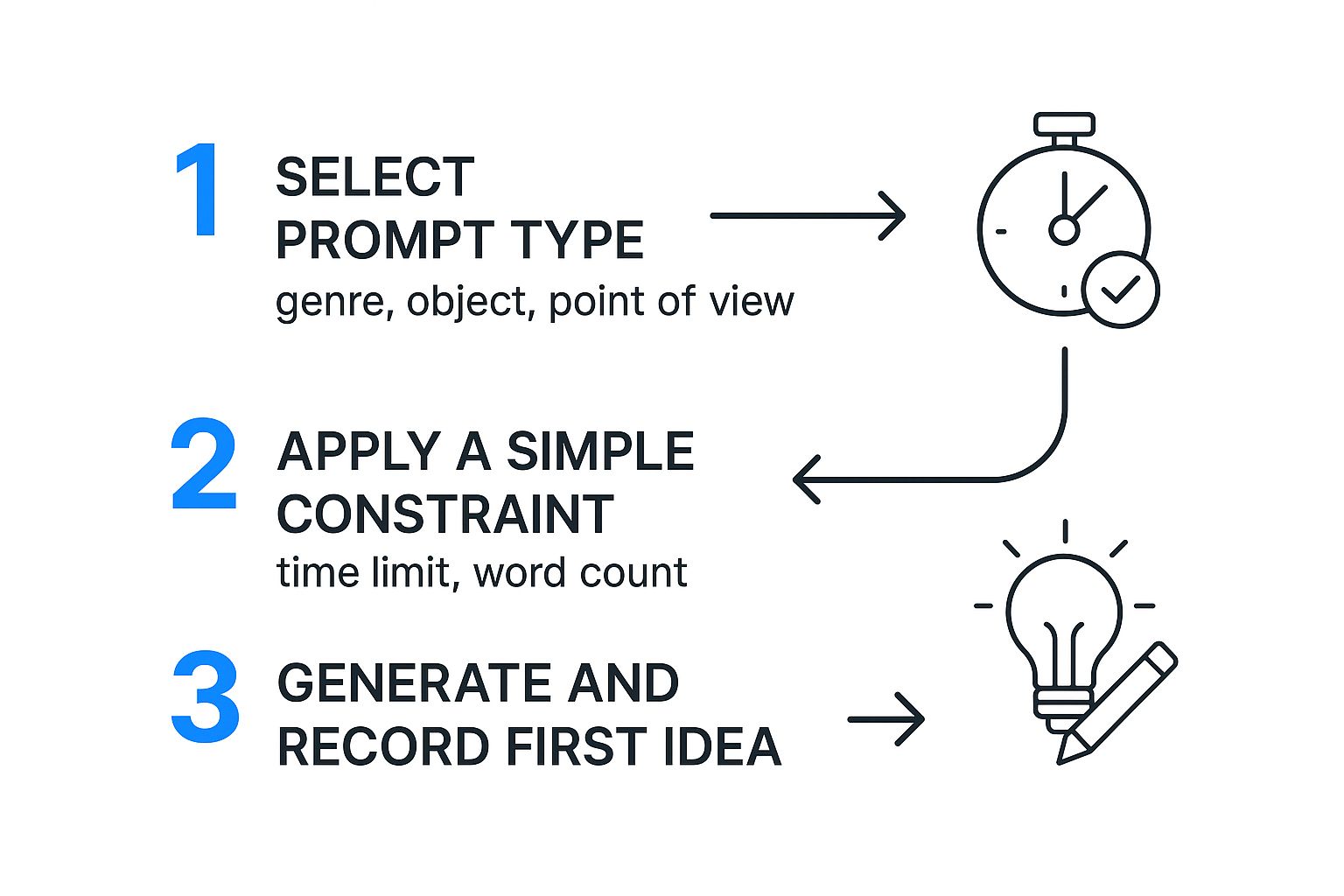How to Come Up with Story Ideas Your Readers Will Love

Coming up with a truly great story idea isn't about waiting for a lightning bolt of inspiration to strike. It’s about building a repeatable process—a way of seeing the world that turns everyday moments, old memories, and weird connections into fertile ground for new narratives.
You can learn to spot the stories hiding in plain sight. It all comes down to actively observing life around you, asking "what if" about your own past, and mashing up totally unrelated concepts to see what happens.
Your Guide to Never Running Out of Story Ideas
We’ve all been there: staring at that blinking cursor on a blank page, the silence getting louder by the second. That intimidation is real, but here's the secret—fantastic story ideas are literally everywhere. The trick is to stop waiting for a muse to show up and start actively hunting for inspiration yourself.
This guide is your map. We're going to ditch the frustration and walk through practical, repeatable methods you can put to work today. Forget the whole "waiting for lightning" thing. It’s time to build a system that keeps your creative well full.
Even a half-formed thought or a simple prompt can be the seed you need. Once you have that initial spark, a tool like Word Spinner can be a huge help in fleshing it out. Its advanced rewriting capabilities let you explore different angles and humanize your text until it flows perfectly, and it guarantees 100% plagiarism-free output.
The Three Pillars of Idea Generation
We’ll focus on three core methods for finding story ideas. Think of these as different lenses for viewing the world, each one revealing a set of possibilities.
This guide is built around these core approaches.
Three Core Methods for Finding Story Ideas
Here’s a quick look at the foundational techniques we'll be exploring. Each one offers a different path to uncovering compelling story concepts.
| Method | Core Principle | Example Starting Point |
|---|---|---|
| Observation | Looking outward at the world around you. | An overheard snippet of conversation at a coffee shop. |
| Introspection | Looking inward at your own life and memories. | A forgotten childhood fear or a powerful, unresolved emotion. |
| Recombination | Creatively blending unrelated elements. | A noir detective story set on a generation ship in deep space. |
Mastering these methods will give you a reliable toolkit for getting ideas on demand.
The world is hungry for fresh narratives. The global digital storytelling market is already valued at around USD 10 billion and is projected to triple by 2032. That's a massive audience waiting for your next idea. Discover more insights about digital storytelling's growth.
This set of methods isn’t just a quick fix for a single dry spell; it’s about building a sustainable creative practice. When you get comfortable with these methods, you stop feeling stuck and start seeing story potential everywhere.
And if you’re facing a particularly stubborn creative wall, our guide on how to bypass writer's block offers more targeted strategies to get you back on track.
Drawing Inspiration From Your Own World
Some of the most powerful stories aren't pulled from thin air—they're dug up from our own backyards. Your life is an unbelievably rich mine for narrative gold. Every memory, triumph, heartbreak, and even the family lore passed down through generations is fair game.
The trick is learning how to look at your own experiences through a storyteller’s lens. This isn't about writing an autobiography. It’s about finding the universal truths hidden in your personal journey and using them as a launchpad for something new.
Think of your memories not as a perfect historical record, but as a collection of emotional starting points.
Asking "What If" About Your Past
The real magic happens when you start asking powerful “what if” questions about your own life. This simple exercise can twist a familiar memory into a completely fresh and exciting story premise. It’s a core technique for any writer trying to generate ideas that feel truly authentic.
Start with a pivotal moment from your life, then change just one crucial detail:
- What if you had taken that job in another city instead of staying home? Who would you be now?
- What if that small, forgotten family argument was actually masking a much deeper secret?
- What if that imaginary friend you had as a kid wasn't so imaginary after all?
These questions pry open the door to fiction, letting you explore alternate paths and heightened realities. The emotional core stays real because it’s rooted in your experience, but the story is suddenly free to go anywhere.
Your personal history is the germ of an idea that can grow in your mind. Much of the world's greatest fiction begins with a memory—a person, a problem, or a conflict that resonated deeply with the author.
Turning Memories into Story Seeds
Ready to start digging into your own life for ideas? Try a few simple reflective exercises. The goal here is to capture raw emotions and sensory details that you can later repurpose for your characters and settings.
Sometimes, looking outside your own experience can help you see the patterns within it. Exploring classic Greek Mythology audio stories, for example, can offer a rich tapestry of characters and plots. You might be surprised how often their ancient struggles mirror our own.
Try these journaling prompts to get the ball rolling:
- Describe Your First Big Failure. Don't just list what happened. How did the air feel? What were you wearing? What was the look on someone else's face? Focus on the raw emotion of the moment.
- Map Out a Family Tree of Secrets. Think about the stories that were only whispered at family gatherings. You don't need to know the actual truth—invent it. What secrets could your great-aunt have been hiding?
- Recall a Moment of Pure Joy. Capture a moment where you felt completely, utterly happy. What caused it? Who were you with? This powerful feeling can become the core motivation for one of your characters.
By exploring these personal territories, you build a unique reservoir of authentic material. Your life becomes an endless source of inspiration, making sure you always have a place to start when the blank page feels intimidating.
Using Creative Prompts to Spark New Ideas
Sometimes, the biggest hurdle isn't a lack of ideas—it's having too much freedom. Staring at a blank page with endless possibilities is enough to paralyze anyone. This is where creative prompts and self-imposed constraints become your secret weapon.
By giving your brain a specific problem to solve, you force it to forge new connections. Instead of waiting for that perfect idea to strike, you’re giving yourself a starting line and a direction. This simple shift can be all it takes to break out of a creative rut and land on some surprisingly original concepts.
This infographic breaks down a simple three-step process for turning a prompt into your first draft.
The real magic happens when you combine a prompt with a constraint, like a word count. It pushes you to stop overthinking, commit to an idea, and just write.
Types of Creative Prompts
Creative prompts come in all shapes and sizes, each designed to nudge your thinking in a different direction. The whole point is to sidestep your usual writing habits and wander into some unfamiliar territory.
Here are a few types of prompts you can try right now:
- Genre Swapping: Write a scene in a genre you’ve never touched. If you live and breathe fantasy, try your hand at a gritty, hard-boiled detective scene. Big on romance? See if you can write a chilling horror opener.
- Object-Based Stories: Pick a random object in your room—that chipped coffee mug, a dusty souvenir, the wilted plant in the corner. Now, make that object the heart of a short story. What’s its secret history?
- Unusual Points of View: Tell a story from a non-human perspective. What has a park bench witnessed over the last decade? What does the cat really think of its owner’s messy life?
If you need a more structured way to get your imagination going, you can find entire collections of creative writing prompts online that are specifically designed to spark fresh ideas.
A writing prompt's job isn't to hand you a perfect story on a silver platter. It’s to get your creative engine running. The first thing you write might not be a masterpiece, but it shatters the inertia and often paves the way for a much better idea.
Curated Prompts to Get You Started
Ready to give it a shot? Here are a few evocative prompts to jumpstart your next writing session. Just pick one and write for 15 minutes without stopping to edit yourself.
- A character discovers a door in their home that wasn't there yesterday.
- Write a story that begins with the line, "It was the last time I ever saw the color blue."
- Two people meet for the first time during a city-wide blackout.
- A librarian finds a strange, handwritten note tucked inside a very old book.
Once you’ve got a rough version cooking, you can use other tools to help polish and refine it. For writers working with AI assistants, learning how to ask ChatGPT to polish your writing is a game-changer for turning a raw idea into a well-crafted piece. These exercises are all about generating quantity at first—the more you practice, the easier it gets to stumble upon those truly unexpected story paths.
Mash Up Unrelated Concepts for Truly Unique Stories
Some of the most original stories come from a simple, almost chaotic technique: taking two completely different ideas and smashing them together. This is often called 'idea blending,' and it's the secret sauce behind a ton of high-concept premises that grab you from the first sentence.
Think about it. A classic Western is familiar. Aliens are familiar. But a Western with aliens? That’s instantly weird and intriguing. You’re forced to ask questions. This method is a fantastic shortcut for bypassing tired tropes and discovering stories that feel both recognizable and refreshingly new.
And this isn't just a trick for novelists. The need for compelling stories is exploding everywhere. In the U.S. alone, searches for 'storytelling marketing' jumped by more than 300% in a single year. That signals a huge hunger for fresh narratives that can cut through the noise. You can see the data on storytelling trends for yourself—the demand for new ways to get ideas is massive.
Build Your Idea Bank First
To make this technique work, you can't just stare at a blank page. You need raw materials. This is where your 'idea bank' comes in—a personal collection of weird, interesting, or thought-provoking things you stumble upon in your daily life. It’s your creative treasure chest.
Start grabbing anything that catches your eye:
- Intriguing Facts: Did you just learn that octopuses have three hearts? Or that a weird historical event had an even weirder, unknown outcome? Jot it down.
- Weird Headlines: Maybe you saw a news story about a mysterious humming sound plaguing a small town. Perfect setting.
- Striking Visuals: A photo of an abandoned theme park or a painting of a lone figure on a cliff can spark an entire mood or character arc.
The goal here isn't to find a story. It's just to collect. Gather a diverse mix of elements you find fascinating and trust that the connections will spark later.
Think of yourself as a creative chef. Your idea bank is your pantry, filled with all sorts of ingredients. The real magic happens when you start mixing flavors nobody else has dared to combine.
The Random Pairing Method
Okay, once your idea bank is looking reasonably full, it’s time for the fun part. The whole point is to force your brain to make connections it would never find on its own. It’s about creating happy accidents.
- Split Your Concepts into Lists: Pull items from your idea bank and create two separate lists. One list could be characters or professions (like a beekeeper, a disgraced astronaut, an antique mapmaker). The other could be for situations or settings (an intergalactic conspiracy, a town where no one can sleep, a secret buried under arctic ice).
- Pair Them Up Randomly: Now for the chaos. Close your eyes and point to one item from each list. Don't overthink it or try to find a "good" one. Let's say you land on "a beekeeper" and "an intergalactic conspiracy."
- Ask the Magic Question: "What If?": This is where you start playing. What if the bees are actually tiny alien drones? What if the beekeeper discovers a secret message hidden in the honeycomb patterns that could expose the entire conspiracy?
This method is so powerful because it bypasses your logical, critical brain and taps straight into raw creativity. Sure, most of the pairings will be duds. But the ones that click? They're often pure gold.
Developing Your Idea From Spark to Story
That first spark of a story idea is pure magic. It’s exciting. It’s also incredibly fragile. To turn that little flicker into a solid foundation you can actually build a story on, you have to give it some shape. This is where you graduate from the abstract "what if" to the tangible building blocks of a narrative.
The whole process kicks off with just a few simple, yet powerful, questions. Think of them as a scaffold you're building around your concept. Start with the absolute basics, because every compelling story, no matter how complex, boils down to just a few core elements.
Asking the Core Story Questions
Before you even dream of writing page one, you need to know who your story is about and what’s at stake. Answering these questions brings your vision into focus and gives you a clear direction, turning a vague idea into a workable premise.
Here are the three non-negotiable questions to nail down first:
- Who is the protagonist? Go deeper than a name or a job. What are their core personality traits? What are their flaws? What makes them interesting, or even better, relatable?
- What do they desperately want? This is the engine of your plot. The goal has to be specific and mean the world to your character. It could be anything from saving the universe to just earning back their family’s respect.
- What is standing in their way? A story without conflict is just a list of things that happened. This obstacle—whether it’s a terrifying villain, a rigid social rule, or the character's own inner demons—is what creates tension and forces your protagonist to act.
A strong idea can almost always be boiled down to these three elements: a compelling character, a clear desire, and a significant obstacle. If you can define these three things, you have a story worth exploring.
From Premise to Pitch
Once you have solid answers to those questions, it’s time to distill your idea into a concise, powerful statement. This isn't just for pitching to agents or editors; it's an essential tool to keep yourself focused while you're lost in the weeds of writing.
Two of the most effective tools for this are the logline and the one-sentence pitch.
- The Logline: This is a one- or two-sentence summary that packs in the protagonist, their goal, the conflict, and the stakes. A classic example: "A determined young wizard discovers his magical heritage and must confront the dark lord who murdered his parents to save the wizarding world."
- The One-Sentence Pitch: This is an even tighter version designed to hook someone instantly. It often leans into the core concept or an ironic twist. For instance: "A dinosaur theme park's security system fails, forcing visitors to fight for survival against resurrected prehistoric predators."
Crafting these little summaries forces you to identify the absolute heart of your story. Of course, as you get deeper into development, you'll find that your prose and dialogue need work. Improving those early drafts is critical. If you're looking to polish your writing and sidestep common mistakes, our article on using ChatGPT for story editing has some incredibly helpful tips.
These early steps are all about building a strong, clear foundation. With a well-defined character, goal, and conflict, your initial spark has a much better chance of growing into a blazing fire.
Crafting Ideas That Connect Emotionally
A clever plot is impressive, sure. But a story that makes you feel something? That’s unforgettable.
The real secret to writing stories that stick with readers long after they’ve finished is building them around a strong, relatable emotional core. This is where you graduate from a simple sequence of events to a truly powerful narrative.
Forget starting with a crazy plot twist or a high-concept world for a moment. Instead, start with a feeling. Think about the big, universal themes that drive all of us: the ache of belonging, the sting of betrayal, the quiet relief of forgiveness, or the unexpected discovery of courage. These are the foundations of stories that truly connect.
Find the Feeling First
Before you even think about outlining a single scene, ask yourself one crucial question: What do I want my reader to feel? Is it hope? Dread? Righteous anger?
Once you nail down that central emotion, it becomes your compass. It will guide every single decision you make, from who your characters are to what happens to them.
This approach gives your story genuine weight. It’s not just a creative whim, either—the science backs it up. Storytelling is a powerful tool for forging deep emotional bonds. When we get lost in a good story, our brains release oxytocin and dopamine, which strengthen our memory and our sense of connection. It's no wonder 73% of consumers are more likely to buy from brands they feel connected to through genuine narratives.
Build Around an Emotional Arc
With your core emotion in hand, you can now build your character’s journey around it. A character’s emotional arc is their inner transformation—the real meat of the story.
Here are a few starting points to get you thinking:
- Belonging: A lonely outcast finally finds a family, only to see that new connection threatened.
- Betrayal: A loyal soldier discovers the cause they’ve dedicated their life to is built on a terrible lie.
- Courage: A timid, overlooked character is forced to stand up for something they believe in, terrified but determined.
A character's internal journey is often far more compelling than any external battle. Their struggle to overcome fear, shame, or grief is what makes them feel real and gets us invested in their fate.
Focusing on the emotional core right from the start gives your story a powerful, unifying theme. It provides the "why" behind your character's actions and makes their journey matter to the reader. Building this kind of depth can be a challenge, but modern tools can help. For instance, a sophisticated writing assistant like Word Spinner is fantastic for giving your prose a natural tone and making sure your writing sounds human, not robotic, while removing AI detection.
Of course, the key is to show, not just tell, these feelings. Our guide on how to show and not tell when writing offers practical techniques to bring these internal states to life on the page, making sure your story lands with the maximum emotional impact.
Got Questions About Finding Story Ideas? We've Got Answers
Every single writer I know, myself included, eventually stares at a blank page and thinks, "Is this it? Have I run out of ideas?" It's a completely normal part of the creative cycle.
Let's break down some of the most common anxieties that bubble up when you're on the hunt for that next great story.
What if My Idea Feels Unoriginal?
This is the big one, isn't it? The fear that your brilliant idea has already been done a thousand times. But here's the secret: originality is a myth.
What truly matters is your unique execution. It's your voice, your specific characters, and the lens through which you see the world that makes a story fresh. You can take a classic "haunted house" premise, set it on a deep-sea research station, give the protagonist a crippling fear of tight spaces, and suddenly, it's a whole new beast.
How Do I Know if an Idea Is Good Enough?
A killer story idea usually clicks into place with three core elements: a compelling character, a clear goal, and a massive obstacle.
Can you answer these three questions?
- Who is this story about?
- What do they desperately want?
- What is standing in their way?
If you have solid answers, you're on the right track. And if the idea is still buzzing in your head a few days later, refusing to leave you alone? That's your sign. That's the one.
I Have Too Many Ideas—How Do I Choose Just One?
First off, congratulations! This is a fantastic problem to have. The best advice I can give is to follow the energy. Which idea makes you want to drop everything and start writing right now?
Passion is the fuel that will get you through the tough middle act of any long project. Another great trick is to just free-write a single page for each of your top three contenders. Usually, one will start to flow so much more easily than the others, making the choice for you.



